Real World DirectX 10 Performance: It Ain't Pretty
by Derek Wilson on July 5, 2007 9:00 AM EST- Posted in
- GPUs
Company of Heroes
While Company of Heroes was first out of the gate with a DirectX 10 version, Relic didn't simply recompile their DX9 code for DX10; Company of Heroes was planned for DX10 from the start before there was any hardware available to test with. We are told that it's quite difficult to develop a game when going only by the specifications of the API. Apparently Relic was very aggressive in their use of DX10 specific features and had to scale back their effort to better fit the actual hardware that ended up hitting the street.
In spite of the fact that Microsoft requires support for specific features in order to be certified as a DX10 part, requiring a minimum level of performance for features is not part of the deal. This certainly made it hard for early adopters to produce workable code before the arrival of hardware, as developers had no idea which features would run fastest and most efficiently.
In the end, a lot of the DX10 specific features included in CoH had to be rewritten in a way that could have been implemented on DX9 as well. That's not to say that DX10 exclusive features aren't there (they do make use of geometry shaders in new effects); it's just that doing things in a way similar to how they are currently done offers better performance and consistency between hardware platforms. Let's take a look at some of what has been added in with the DX10 version.
The lighting model has been upgraded to be completely per pixel with softer and more shadows. All lights can cast shadows, making night scenes more detailed than on the DX9 version. These shadows are created by generating cube maps on the fly from each light source and using a combination of instancing and geometry shading to create the effect.
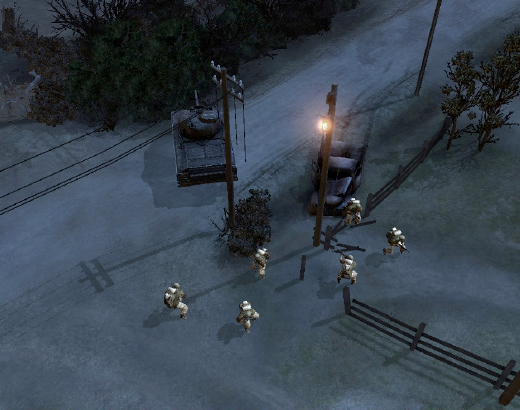
Company of Heroes DirectX 9
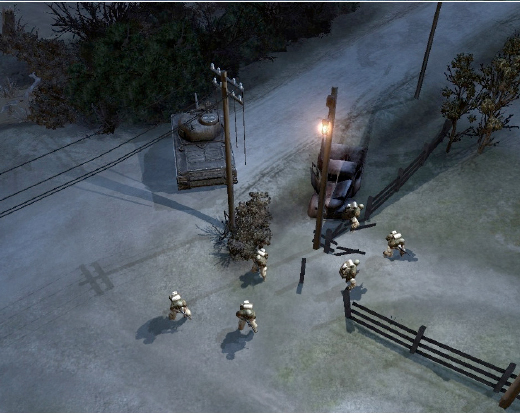
Company of Heroes DirectX 10
There is more debris and grass around levels to add detail to terrain. Rather than textures, actual geometry is used (through instancing and geometry shaders) to create procedurally generated "litter" like rocks and short grass.
Triple buffering is enabled by default, but has been disabled (along with vsync) for our tests.
We discovered that our cards with 256MB of RAM or less had trouble running with 4xAA and DirectX 10. Apparently this is a known issue with CoH on 32-bit Vista running out of addressable memory. Relic says the solution is to switch to the 64-bit version of the OS, which we haven't had time to test out quite yet.
DirectX 9 Tests
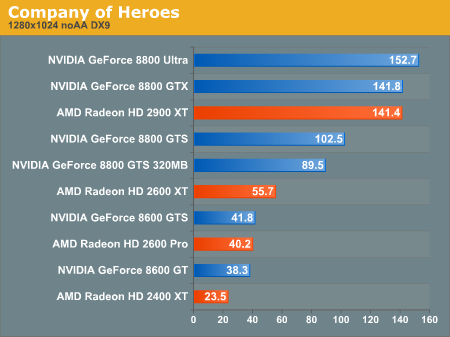
Company of Heroes DX9 Performance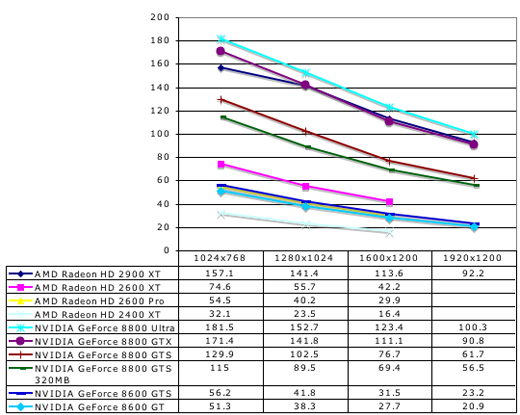

Company of Heroes 4xAA DX9 Performance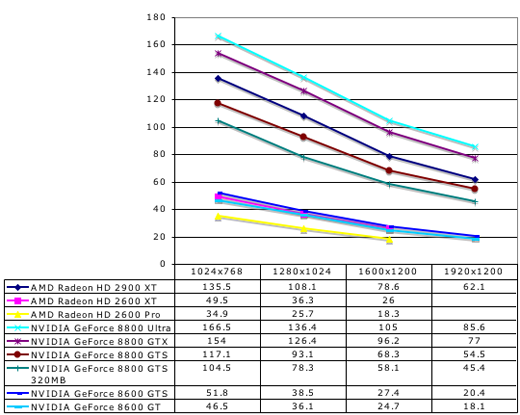
Under DX9, the Radeon HD 2900 XT performs quite well when running Company of Heroes. The card is able to keep up with the 8800 GTX here. In spite of a little heavier hit from enabling 4xAA, the 2900 XT still manages to best it's 8800 GTS competition. But the story changes when we move to DX10.
DirectX 10 Tests
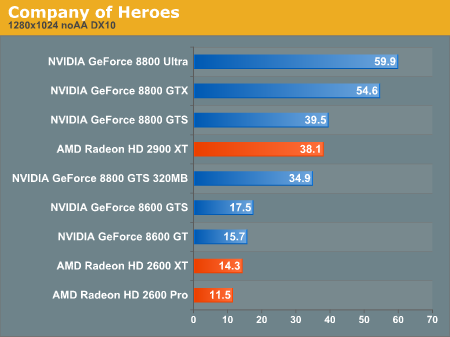
Company of Heroes DX10 Performance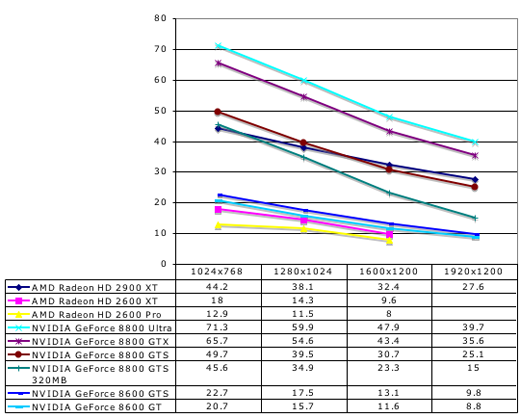
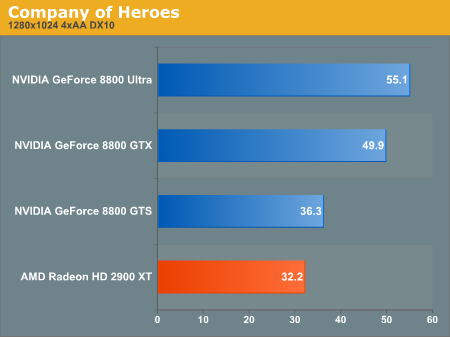
Company of Heroes 4xAA DX10 Performance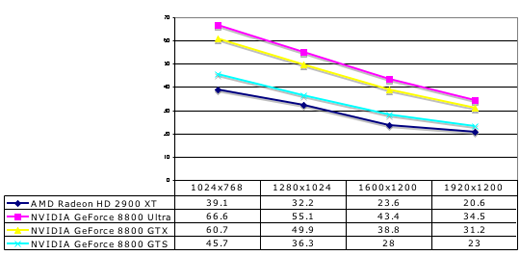
When running with all the DX10 features enabled, the HD 2900 XT falls to just below the performance of the GeForce 8800 GTS. Once again, the low-end NVIDIA and AMD cards are unable to run at playable framerates under DX10, though the NVIDIA cards do lead AMD.
Enabling 4xAA further hurts the 2900 XT relative to the rest of the pack. We will try to stick with Windows Vista x64 in the future in order to run numbers with this game on hardware with less RAM.
While Company of Heroes was first out of the gate with a DirectX 10 version, Relic didn't simply recompile their DX9 code for DX10; Company of Heroes was planned for DX10 from the start before there was any hardware available to test with. We are told that it's quite difficult to develop a game when going only by the specifications of the API. Apparently Relic was very aggressive in their use of DX10 specific features and had to scale back their effort to better fit the actual hardware that ended up hitting the street.
In spite of the fact that Microsoft requires support for specific features in order to be certified as a DX10 part, requiring a minimum level of performance for features is not part of the deal. This certainly made it hard for early adopters to produce workable code before the arrival of hardware, as developers had no idea which features would run fastest and most efficiently.
In the end, a lot of the DX10 specific features included in CoH had to be rewritten in a way that could have been implemented on DX9 as well. That's not to say that DX10 exclusive features aren't there (they do make use of geometry shaders in new effects); it's just that doing things in a way similar to how they are currently done offers better performance and consistency between hardware platforms. Let's take a look at some of what has been added in with the DX10 version.
The lighting model has been upgraded to be completely per pixel with softer and more shadows. All lights can cast shadows, making night scenes more detailed than on the DX9 version. These shadows are created by generating cube maps on the fly from each light source and using a combination of instancing and geometry shading to create the effect.

Company of Heroes DirectX 9

Company of Heroes DirectX 10
There is more debris and grass around levels to add detail to terrain. Rather than textures, actual geometry is used (through instancing and geometry shaders) to create procedurally generated "litter" like rocks and short grass.
Triple buffering is enabled by default, but has been disabled (along with vsync) for our tests.
We discovered that our cards with 256MB of RAM or less had trouble running with 4xAA and DirectX 10. Apparently this is a known issue with CoH on 32-bit Vista running out of addressable memory. Relic says the solution is to switch to the 64-bit version of the OS, which we haven't had time to test out quite yet.
DirectX 9 Tests




Under DX9, the Radeon HD 2900 XT performs quite well when running Company of Heroes. The card is able to keep up with the 8800 GTX here. In spite of a little heavier hit from enabling 4xAA, the 2900 XT still manages to best it's 8800 GTS competition. But the story changes when we move to DX10.
DirectX 10 Tests




When running with all the DX10 features enabled, the HD 2900 XT falls to just below the performance of the GeForce 8800 GTS. Once again, the low-end NVIDIA and AMD cards are unable to run at playable framerates under DX10, though the NVIDIA cards do lead AMD.
Enabling 4xAA further hurts the 2900 XT relative to the rest of the pack. We will try to stick with Windows Vista x64 in the future in order to run numbers with this game on hardware with less RAM.










59 Comments
View All Comments
DerekWilson - Thursday, July 5, 2007 - link
this is true -- our current information shows that AMD does relatively worse than NVIDIA when compared under DX10 than under DX9.rADo2 - Thursday, July 5, 2007 - link
"there are applications where the 2900 xt does outperform its competition" - where? 2900XT has 22FPS, 8800GTX 24FPS nad 8800ULTRA 26FPS. Despite "crippled for NVIDIA" / "paid by ATI" I see still green camp to outperform ATI.And in Lost Planet NVIDIA has 2x (!) better performance.
It is not even worth considering ATI for purchase.
smitty3268 - Thursday, July 5, 2007 - link
Read the comment again: The point is that the 2900XT does not compete against the 8800GTX, it competes against the 8800GTS, which it did outperform in that test.It certainly isn't the fastest card available, but I could also make a statement like "The GeForce7300Go outperforms it's competition" without saying it's the fastest thing available. I'm just saying it beats the cards in a similar price range.
KeithTalent - Thursday, July 5, 2007 - link
Um, what about price? Last time I checked the 8800GTX still costs about $150 more than the 2900XT. I will not even bring up the Ultra which is still way overpriced.So for $150 less you get a card that competes with the GTX some of the time and is more than capable of playing most games maxed out at high resolution. That is why the 2900XT is worth considering for purchase.
KT
rADo2 - Thursday, July 5, 2007 - link
Problem is, 2900XT is many times NOT playable. Its performance is sometimes close to NVIDIA, sometimes 2x lower. And this applies for both DX9 and DX10. With 60+ games I own, I can assume ATI would "suck" on 30 of them.Look at Lost Planet with AA, 22FPS versus 40-50FPS is a huge difference in playability. On 8800GTX/ULTRA you can play even at 1920x1200 (30FPS), with 2900XT even 1280x1024 is giving you problems.
KeithTalent - Thursday, July 5, 2007 - link
Well I have two of them and they work more than fine on every single game I have tried so far, including demos, betas, and a couple of older games (using Catalyst 7.6).Lost Planet is a POS port anyway, but when I ran the test benchmark in DX9 with Crossfired 2900XTs I had frames well above 40 with everything maxed at 1920x1200 so I am somewhat confused by the numbers here. I will have to wait until I am home to see my exact numbers, but they were much higher than what was presented here. Maybe there is something wonky with the beta drivers?
I'll post back tonight once I have verified my numbers.
KT
DerekWilson - Thursday, July 5, 2007 - link
We didn't use the demo benchmark, and the release version (afaik) does not include an updated version of the benchmark either.For the Lost Planet test, we had to use FRAPS running through the snow. This will absolutely give lower performance, as the benchmark runs through a couple in door scenes as well with higher framerates.
I mentioned FRAPS on the test page, but I'll add to the Lost Planet section the method we used for testing.
defter - Thursday, July 5, 2007 - link
Do Intel CPUs outperform currently AMD or not? After all, $200 AMD CPU is about as fast as $200 Intel CPU....It's natural that slower parts have good price/peformance ratio compared to competition since otherwise nobody would buy them. However, this has nothing to do which one fastest...
KeithTalent - Thursday, July 5, 2007 - link
Not sure what you are getting at, I was responding to this ridiculous statement:Which is completely untrue, because price can be a big consideration.
With respect to CPUs, if you spend an extra $50 - $100 for the better Intel processor, you are getting exponentially better performance (I know this from experience), while if you spend $150 more for a GTX, you are getting only marginally better performance.
KT